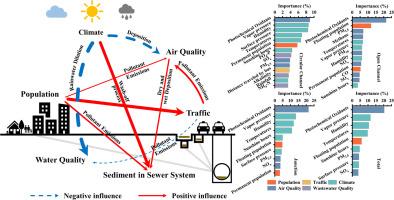当前位置:
X-MOL 学术
›
Water Res.
›
论文详情
Our official English website, www.x-mol.net, welcomes your
feedback! (Note: you will need to create a separate account there.)
Environmental drivers of sediment accumulation in urban sewer systems: a case study of Kyoto City, Japan
Water Research ( IF 11.4 ) Pub Date : 2024-10-29 , DOI: 10.1016/j.watres.2024.122721 Liming Liu, Kenji Kawaike, Keiko Wada, Takahiro Koshiba, Xi Chen, Congji Han, Haruki Matsui
Water Research ( IF 11.4 ) Pub Date : 2024-10-29 , DOI: 10.1016/j.watres.2024.122721 Liming Liu, Kenji Kawaike, Keiko Wada, Takahiro Koshiba, Xi Chen, Congji Han, Haruki Matsui

|
Sediment accumulation can reduce the drainage capacity of sewer systems, and thus increase the risk of urban flooding and jeopardize the safety of urban environments. The interaction between multiple environmental factors drives sedimentation in sewer systems, but this interaction is poorly understood. To fill this gap, this study examined the interaction between five categories of environmental factors (population, traffic, climate, air quality, and wastewater quality: 25 factors overall) and the effects of these factors on sediment accumulation in different sewer system structures (open channels (OCs), circular channels (CCs), junctions) in Kyoto, Japan, from 2014 to 2023. The results showed that population and traffic contributed to sediment accumulation through pollutant emission, whereas climate factors promoted sediment accumulation by enhancing wash-off and the deposition of air pollutants. Most sediment was deposited in OCs and junctions under the combined effects of climate and air quality. Air quality has a greater influence on sedimentation in the OCs than climate, and the opposite is found for Junction, whereas sedimentation in CCs was mainly influenced by the combined effects of climate, air quality, and wastewater quality. Photochemical oxidants, humidity, temperature, and vapor pressure had the greatest impact on sediment deposition in OCs and junctions, while wastewater alkalinity and NH4-N and PO4-P concentration had a non-negligible effect on CCs sedimentation. These results emphasize the key role of climate-driven wash-off and dry/wet deposition, and the localized role of wastewater quality (in CCs), in sewer sedimentation. These insights can inform the predictive modeling of sewer sedimentation during climate change.
中文翻译:

城市下水道系统中沉积物堆积的环境驱动因素:以日本京都市为例
沉积物堆积会降低下水道系统的排水能力,从而增加城市洪涝的风险,危害城市环境的安全。多种环境因素之间的相互作用推动了下水道系统中的沉积,但人们对这种相互作用知之甚少。为了填补这一空白,本研究考察了五类环境因素(人口、交通、气候、空气质量和废水质量:总共 25 个因素)之间的相互作用,以及这些因素对 2014 年至 2023 年日本京都不同下水道系统结构(明渠 (OC)、圆形渠道 (CC)、交界处)沉积物积累的影响。结果表明,人口和交通通过污染物排放促进了沉积物的积累,而气候因素通过加强空气污染物的冲洗和沉积促进了沉积物的积累。在气候和空气质量的共同影响下,大部分沉积物沉积在 OC 和交界处。空气质量对 OC 沉积的影响大于气候,Junction 则相反,而 CCs 的沉积主要受气候、空气质量和废水质量的综合影响。光化学氧化剂、湿度、温度和蒸气压对 OCs 和结部沉积的影响最大,而废水碱度和 NH4-N 和 PO4-P 浓度对 CCs 沉积的影响不可忽视。这些结果强调了气候驱动的冲洗和干/湿沉积的关键作用,以及废水质量(以 CC 为单位)在下水道沉积中的局部作用。这些见解可以为气候变化期间下水道沉积的预测建模提供信息。
更新日期:2024-10-30
中文翻译:

城市下水道系统中沉积物堆积的环境驱动因素:以日本京都市为例
沉积物堆积会降低下水道系统的排水能力,从而增加城市洪涝的风险,危害城市环境的安全。多种环境因素之间的相互作用推动了下水道系统中的沉积,但人们对这种相互作用知之甚少。为了填补这一空白,本研究考察了五类环境因素(人口、交通、气候、空气质量和废水质量:总共 25 个因素)之间的相互作用,以及这些因素对 2014 年至 2023 年日本京都不同下水道系统结构(明渠 (OC)、圆形渠道 (CC)、交界处)沉积物积累的影响。结果表明,人口和交通通过污染物排放促进了沉积物的积累,而气候因素通过加强空气污染物的冲洗和沉积促进了沉积物的积累。在气候和空气质量的共同影响下,大部分沉积物沉积在 OC 和交界处。空气质量对 OC 沉积的影响大于气候,Junction 则相反,而 CCs 的沉积主要受气候、空气质量和废水质量的综合影响。光化学氧化剂、湿度、温度和蒸气压对 OCs 和结部沉积的影响最大,而废水碱度和 NH4-N 和 PO4-P 浓度对 CCs 沉积的影响不可忽视。这些结果强调了气候驱动的冲洗和干/湿沉积的关键作用,以及废水质量(以 CC 为单位)在下水道沉积中的局部作用。这些见解可以为气候变化期间下水道沉积的预测建模提供信息。


















































 京公网安备 11010802027423号
京公网安备 11010802027423号